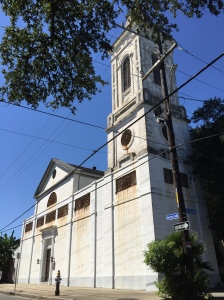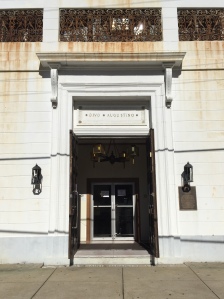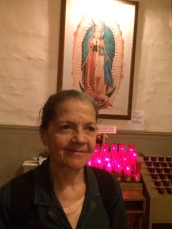Saint Augustine Church
“Today we celebrate the 173rd anniversary of St. Augustine Church,” said the woman from the pulpit, moments before the procession began. While I’ve been traveling for this project, one of the hardest decisions has been which church to visit on a Sunday morning. I only have one Sunday morning in town and there are always so many great options. By the time I woke up this Sunday, I had narrowed it down to two churches. So, I did what any sensible 21st century netizen would do. I crowdsourced my decision. My Facebook friends resoundingly voted for St. Augustine. When I arrived, I was very happy to learn I was there during an anniversary celebration. How auspicious! (Thank you, FB friends.)
Saint Augustine Church stands on a piece of land that was part of the original Claude Treme plantation. Treme eventually subdivided his estate and began selling large tracts to free blacks and other buyers. A pamphlet at the church explains, “When the free people of color got permission from Bishop Antoine Blanc to build a church, the Ursuline Sisters donated the property at the corner of Bayou Road and Saint Claud, on the condition the church was named Saint Augustine, after one of their patron saints. And so it came to pass.”
“We are a church that is rooted in our history, but present in this moment,” says Pastor Rev. Emmanuel Mulenga, O.M.I. That history is rich and groundbreaking. In 1842, a few months before the dedication of the church, people of color began buying pews for their families. The pamphlet continues, “Upon hearing of this, white people in the area started their campaign to buy pews. Thus the War of the Pews began and was ultimately won by the free people of color, who bought three pews to every one purchased by the whites. In an unprecedented political and religious move, the colored members also bought all the side aisle pews. They then gave those pews to the slaves as their exclusive place of worship.”
This is a Catholic mass unlike any I’ve attended. All of the elements of the mass are there, but the music is joyous, loud and distinctly New Orleans. The choir consists of some eight to twelve singers who are accompanied by piano, saxophone, drums and percussion. Music is conducted by choir director, Carol LeBlanc, who alternates between piano and electric keyboard. The congregation claps, sings aloud and a few have tambourines. It is a soulful celebration, without a doubt.

Photos are only allowed before and after mass, so this is what it looked like after the pews had cleared.
It is one thing to visit this church and stand in awe of its history, of the role it played in the development of this city. It is a powerful thing to sit in the very pews that, as a sign indicates, “were reserved for and used exclusively by slaves from the date of the church’s dedication, October 9, 1842, until the slaves were freed after the Emancipation Proclamation in 1863.” This sacred space is a house in which faith, politics, slavery, freedom, and race are inseparable. And it is yet another powerful thing to experience the mass here and see that this is not a museum or a monument, it is a living and thriving community even to this day.
Father Mulenga, who is originally from Zambia, has been at the church for only about three months. He preaches a fiery and uplifting service that challenges parishioners not to dwell in the past. In alluding to the rich heritage of this church, he says, “We like to say, ‘We used to…’ a lot.” He talks about times when the church has had to hold three masses on Sunday to accommodate the numbers of people. Today, the congregation has dwindled significantly. “We have a history to celebrate. But we must move forward.” I look around and it seems to me the place is quite packed, it doesn’t look like a dwindling congregation to me. And it certainly doesn’t sound like one, either. People agree with resounding “amens,” there’s applause, there’s a sense that this is the pastor the church needs right now.
One of the perhaps unintended results of the “War of the Pews” in 1842 was that Saint Augustine became the most integrated congregation in the country. The pamphlet states that there was “one large row of free people of color, one large row of whites with a smattering of ethnic folk, and two outer aisles of slaves.” Today, this is still a diverse congregation, racially and generationally.
After the mass, as we make our way to the fellowship hall for an anniversary reception, Father Mulenga greets me warmly. I mention how much I’ve enjoyed the mass and he tells me this is an exciting place. I have to agree, as I’m still glowing from the impassioned rendition of “We Are Standing On Holy Ground” with which the service ended. This is indeed holy ground, in every sense of the word. And I’m so grateful to have been here.

The Tomb of the Unknown Slave is located in the garden plot of Saint Augustine Church. This shrine, consisting of grave crosses, chains and shackles is dedicated to the memory of the nameless, faceless, turfless Africans who met an untimely death in Faubourg Treme.











